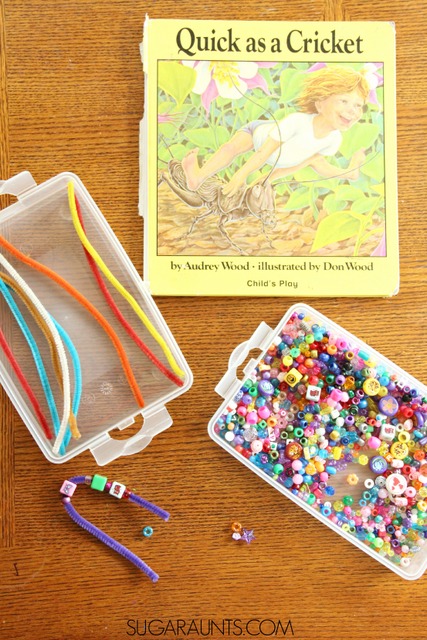Many years ago, we made empathy bracelets as one of our favorite empathy activities for kids. Empathy activities like this bracelet craft are easy ways to teach kids about empathy as a foundation for social emotional skills. We made empathy bracelets as a way to develop social-emotional awareness and self-awareness of others and how they feel. When you use a hands-on activity like this bead activity to teach abstract concepts like empathy, children can stimulate thinking and allow kids to grasp the perspectives of others. Use the empathy beads and the Quick as a Cricket activity idea here to help kids think about others and the world around them.
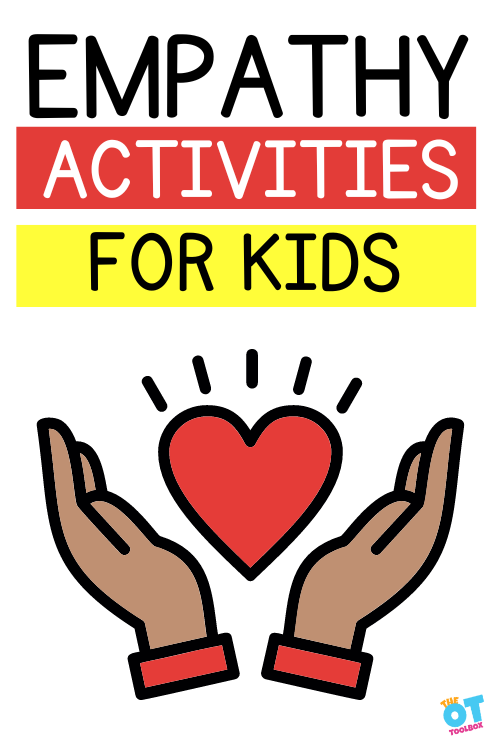
Amazon affiliate links are included in this blog post. As an Amazon Influencer, I earn from qualifying purchases.
Empathy Activities for Kids
One fun way to teach kids about empathy is with the children’s book, “Quick as a Cricket”. By using this book about feelings, and a fun activity that can be adjusted to meet the needs of various kids, teaching about feelings and values is meaningful.
This book really hits on the self-awareness of a child as they see that each feeling in the book makes up a part of him. We thought that if this boy is feeling all of these emotions about himself, then others are too! If you are looking for for more activities based on children’s books then we have a lot to share with you!
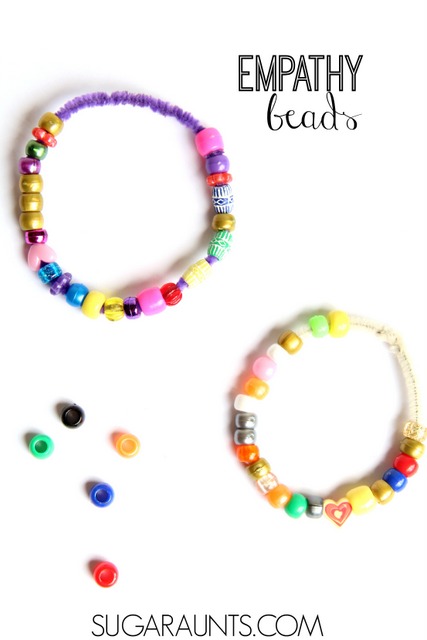
Activity to teach empathy
Teaching kids about empathy is important. There are studies that show us that specifically teaching kids about empathy makes a difference. In fact, when we teach kids about empathy in ways that make sense to them (or are meaningful), we may see more positive positive social behaviors, such as sharing.
Helping others becomes more meaningful as well. Additionally, research tells us that kids that learn about empathy are less likely to be antisocial or present with uncontrolled aggressive behaviors.
Additionally, it’s been said that empathy and perspective taking serve an important role in what is called prosocial behavior, or helping others, sharing, taking turns, etc.
One way to support this awareness of the feelings and needs of others is through serving others. Doing various acts of kindness can teach this skill in a practical and real life way. Check out our list of service ideas for ways to help others while developing empathy.
After reading the book Quick as a Cricket, (just a few dozen times–this is a book you WILL read over and over again!), we talked about how each of us has many feelings that can be seen in animals.
Some of our feelings happen daily, and some not for a while. Other feelings pair together (feeling small and sad).
Kids can have a difficult time with learning to be empathetic. My kids really got an understanding of empathy as we talked about how other people might feel these feelings and we should be aware. To take the empathy lesson a bit further, we made Empathy Bracelets with our empathy beads!
Empathy Activity
Today, I have a fun friendship activity that uses a classic children’s book. Kids can struggle with the abstract concept of empathy and the perspectives of others.
This empathy activity is part of a bigger picture when it comes to empathy skills. When we notice and are aware of how we feel, and how those feelings make us act, we can have sympathy and awareness for others. The first step is to do an emotions check in followed by a feelings check in. While similar, they both play a role in being aware of how we feel and the emotion terms associated with those feelings. We can then reflect on how others might feel when they are in a similar situation.
This Quick as a Cricket activity will be a hit at your book club play date, or any day! I loved the simplicity of our activity as it really went well with the simple rhyme of the book’s text.
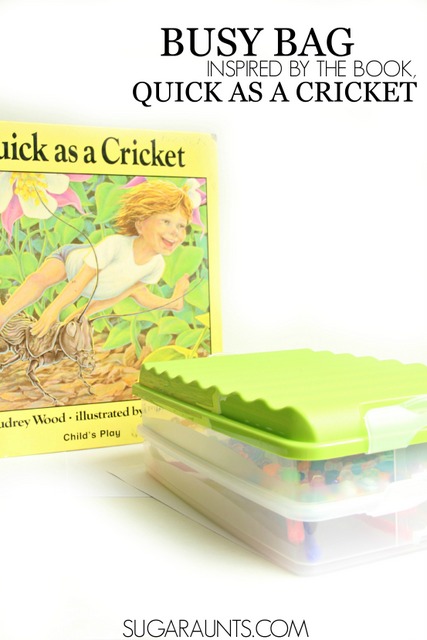
This post contains affiliate links.
To discuss and learn more about empathy, we used just a few items. First, we read the book, Quick as a Cricket, (affiliate link) by Audrey Wood. If you haven’t read this classic book, it’s one you definitely want to find!
The boy in the book discovers the characteristics of animals make up parts of himself. The book has simple rhyming words and captures children’s attention. It’s a great book to discuss self-awareness and feelings that make up all of us.
Empathy Bracelets
You’ll need just two items to make empathy bracelets with kids:
- Pipe cleaners
- Beads
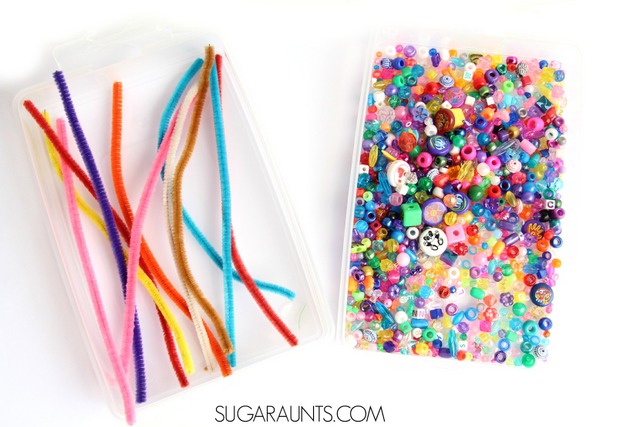
We grabbed a handful of colorful pipe cleaners.
To make our empathy bracelets, we used a bunch of different colored beads. (affiliate link) Some of the beads were different shapes and sizes, and that fit in perfectly with our empathy talks.
People come in different shapes and sizes but we all have the same feelings inside!
To create the Quick as a Cricket (affiliate link) activity, I used our snap and stack (affiliate link) containers. This worked great as a busy bag storage system so the kids could create bead bracelets whenever they wished as a quiet activity.
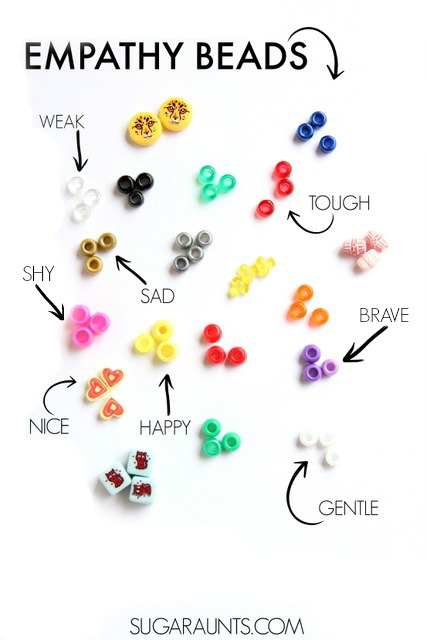
Before making the empathy bracelets, we read through the book once more.
We looked at each of the animals and talked about their color and found a bead that went along with the animal.
We discussed the feeling or description of the animal and how we sometimes show those feelings.

Then we made our bracelets. It was fun to see how each of my kids made their bracelets differently. One just plucked the beads from the bin and said the feeling that went along with that color.
Another flipped through the book and matched up beads to the animal.
Each empathy bracelet is different as it is made by a different child. But, they all mean the same thing; they represent the feelings that we all share!
When you make these empathy bracelets, you could pull out colors to match the animals or feelings, or you could just let the child create as they wish. It is completely up to you!
You can talk about empathy and kindness in many ways using activities with kids. Mine loved this Little Blue and Little Yellow book activity to promote kindness, too.
Kids will love to wear their bracelets and fiddle with the beads. As they fidget with the individual beads, they can remember the feeling that is associated with that bead. They might see someone who is having a bad day and recognize the emotion.
Encourage empathetic respect of other’s feelings even when your child is not feeling that same way. You can explain that not everyone has the same beads or colors of beads on their bracelet (or might not be wearing a bracelet!) but they still have those feelings and emotions inside of them.
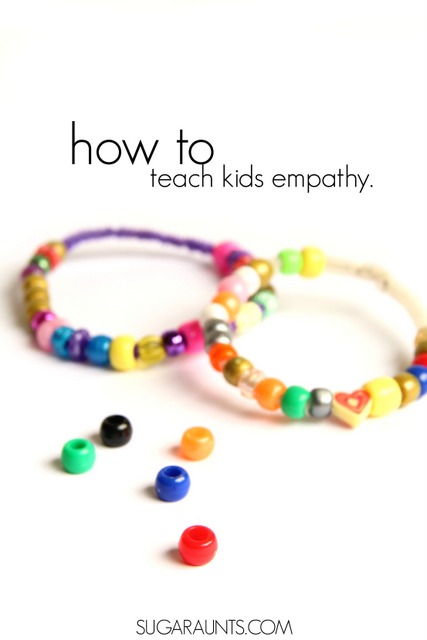
Empathy Activities for Kids
For fun and hands-on empathy activities for kids, grab our social emotional skills resource, Exploring Books Through Play: 50 Activities based on Books About Friendship, Acceptance, and Empathy, that explores friendship, acceptance, and empathy through popular (and amazing) children’s books! It’s 50 hands-on activities that use math, fine motor skills, movement, art, crafts, and creativity to support social emotional development.
- Use plastic eggs to work on empathy by writing various scenarios on strips of paper. Kids can open an egg and state how they would feel in the scenario. This is a great group activity.
- Try these empathy activities from Positive Psychology Program.
- Use dolls and puppets. Act out scenarios and record the story on a phone or tablet. Kids can re-watch and describe the various feelings and how the characters felt and acted.
- For kids with autism, modeling, prompting, and reinforcement are strategies that can help.
- Read books! These chapter books that teach empathy are great for the older kids or using as read-aloud books with the whole family. They are great ways to spark conversations about empathy.
- Writing about Friendship Slide Deck – writing prompts, writing letters to friends, and handwriting activities to develop friendship skills, all on a free interactive Google slide deck.
- Create a social story about specific events or tasks that involve other individuals. This can create options for the individual to use during a task and can help when there may be unexpected situations to navigate that lead to feelings of anxiety or worries leading up to a social situation or activity.
- Children can benefit from perspectives of others, including through personal space. Use this Personal Space Friendship Skills Slide Deck as a tool to address body awareness and personal space among others. Friendship involves allowing personal space, and body awareness and all of this is part of the social skill development that some kids struggle with. Use this free Google slide deck to work on body awareness and personal space.
- Here are five simple activities to teach empathy to preschoolers.
- Pretend play is a wonderful way to teach empathy to young children. You can do this as an adult directed activity, through puppets or assigning roles to children during large group times. Encouraging a child child to be sad for a specific reason and having another child take care of them, will help children learn body language of others.
- Emotion activities that are available to complete on a daily basis, help children learn how to name different feelings in themselves and identify those feelings in others.
- Friendship activities such as these friendship activities.
- Using Book-related play activities- This digital download contains 50 hands-on, multi-sensory play-centered activities for anyone helping kids learn about friendship, acceptance, empathy, compassion, and differences in others. These activities encourage cooperation, negotiation and communication through play.
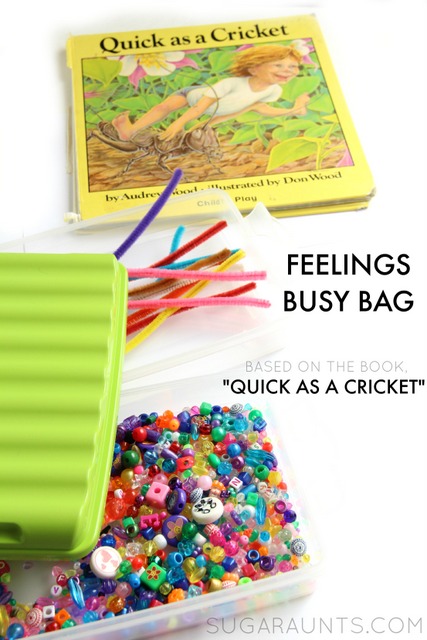
More Quick as a Cricket Activities
Expand on the empathy activities with other Quick as a Cricket activities that involve play and movement. First, pick up the book, Quick as a Cricket. (affiliate link) Then use the empathy beads activity here along with these functional activities to inspire development:
Quick as a Cricket Snack from Craftulate can get kids busy in the kitchen building skills like executive functioning and fine motor skills.
Quick as a Cricket Sensory Play from Still Playing School includes play and sensory based learning.
Quick as a Cricket Art from Fun-a-Day inspires fine motor skills and motor development.
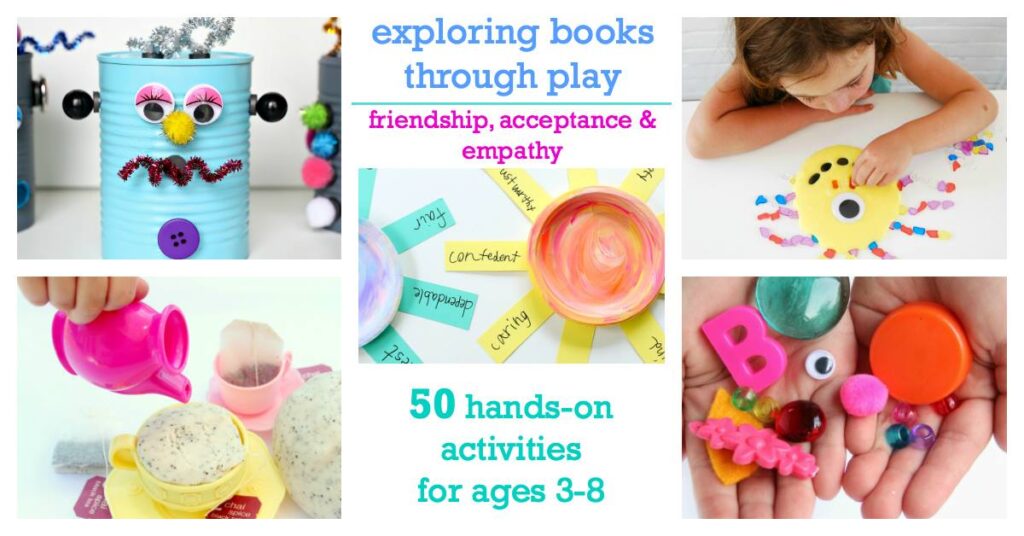
References on empathy skills
Schrandt, J. A., Townsend, D. B., & Poulson, C. L. (2009). Teaching empathy skills to children with autism. Journal of applied behavior analysis, 42(1), 17–32. doi:10.1901/jaba.2009.42-17
What is Empathy?
Empathy is the development of care for others. When I was young, my mom always told me to say “I’m sorry” when I was in a conflict with my cousin. Sometimes I didn’t feel sorry (after all, he’s the one that took the ninja turtle from me first,) but I did what I was told. After a while, saying “I’m sorry” felt repetitive with no actual meaning behind it.
Instead of teaching children to say “I’m sorry,” what would happen if we helped our kids understand how another person is feeling, and respond with care for that person’s feelings. This is called empathy.
Empathy Development in Kids
Did you know the ability to use and practice empathy in everyday situations is not a born skill and that there are actually specific and defined stages of empathy development? It’s true!
There is real power to the development of empathy in the first five years of a child’s life. Not only do children need to understand who they are as a person, but how others feel. Empathy isn’t something that can be forced on a child, but it is something they can become familiar with and understand through adult support and play based activities.
stages of empathy development
Here, we are covering the stages of empathy development and some activities that preschoolers can participate in, to understand and practice empathy.
Empathy is a complex skill that is learned over time.
From the time a child is born, they open their eyes and notice that they aren’t the only being! There’s mom, dad, nurses and they all do everything possible to get the baby’s needs met. As a child grows, they are introduced to siblings, cousins, peers and other adults. Every interaction a child has, provides them with opportunities to understand social structure and engagement.
According to this article by Professor Martin L. Hoffman, the main theorist on the development of empathy in childhood, “there must be parallelism of feelings and affections with thoughts, moral principles, and behavioral tendencies.”
According to this article in “The Matter of Style” the 4 stages of empathy include the following:
“ First stage (global empathy)
It comprises the first year of a person’s life and consists of the fact that the child does not yet perceive others as different from himself. For this reason, the pain that he perceives in the other is confused with his own unpleasant feelings, as if it were happening to himself. For example, the baby who, on seeing his mother crying, dries his own eyes.
Second stage (egocentric empathy)
It corresponds to the second year of life, and the child is aware that it is the other person who is going through the unpleasant situation. However, she assumes that the internal states experienced by the other person are being felt by herself.
Third stage of the child’s development of empathy (empathy for the feelings of others)
It runs from the second to the third year. The child is aware that the feelings he experiences are different from those of the other person, and is able to respond to them in a non-self-centered way. At this point, she is already in a position to understand that the other person’s intentions and needs differ from her own and, therefore, that person’s emotions may also differ from her own. Thus, for example, she becomes able to console.
Fourth Stage (empathy for the life condition of others)
It comprises the final period of childhood. The feelings of others are perceived not only as reactions of the moment, but also as expressions of their general life experience. That is, they respond differently to transitory and chronic states of pain, since they take into consideration the general condition of the other.”
How to support empathy development in each stage
Ages 0–12 Months: Supporting strong, secure attachments in infants, is essential at this age. As children learn that others are understanding how they are feeling, and are supported by getting their needs met, babies learn that their emotions and feelings can be understood by other, even before they can talk.
Ages 1–3 years: To help toddlers develop empathy, describe their feelings to them, and the feelings of others around them. This is helpful when they are engaging in play with other kids, as toddlers have a harder time managing their emotions. For example, “When Sandy was sad, it was so nice that you gave her some ice to help her leg feel better.”
Ages 3–5 years: In the preschool years, children are learning how to respond to their feelings and the feelings of others. Adults can support empathy development by asking open ended questions and providing concrete ways for children to calm down and express their feelings. Through using emotional tools such as pretend play-based activities, children are able to regulate their feelings and learn how to communicate their needs to others.
A 6 year old boy recently saw his 3 year old brother become upset because he couldn’t climb as high on the play structure. The 6 year old could use toys to help his brother and asked him if he needed help calming down. Once calm, his brother helped his 3 year old get a step stool so he could reach the rung on the bottom of the play structure.
The social and emotional measures in this preschool rating scale, includes empathy goals for children ages 19 months and up. As empathy development becomes a focus in Early Childhood and essential for Kindergarten readiness, teachers and parents are looking for more easy to teach empathy through play.
A final note on empathy
Empathy is something that isn’t taught to children, but a skill developed over time. Starting with strong, positive attachments in early childhood. When children have the opportunities to practice developing their social skills by being provided a variety of opportunities to engage in play throughout early childhood, their empathy grows exponentially. Adults can support the development of empathy in early childhood by asking open ended questions, creating opportunities for children to practice developing friendships through play, and providing children with concrete ways to respond to big feelings in themselves and others.


